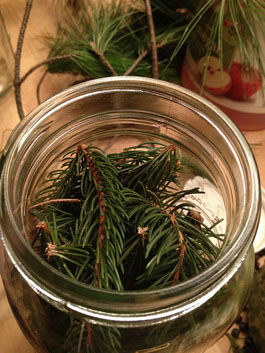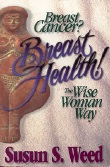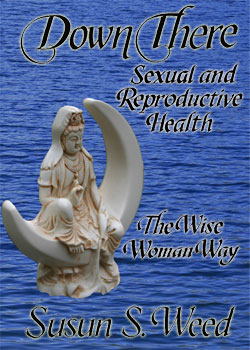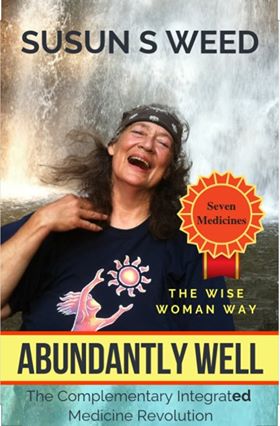There is so much to learn about herbs and healing. How can we assure ourselves of our own competence? How can we feel safe in our recommendations? How can we know which herb is best to use for a particular person? Do we need a system of diagnosis interlocked with categories of herbs? (For instance, the four humor theory that categorizes illnesses and herbs according to the humors, or the Ayurvedic system that divides people into three types and selects herbs accordingly.) These are questions that have concerned healers for thousands of years and still concern us today.
I do not think the answer lies in a license. I don't think the answer is to study more, read more books or go to school, if what happens is that one picks up a dogma, and sticks to that. Neither license nor dogma guarantee that what we tell others to do for the sake of health will be safe or effective.
The answer lies in our commitment to ourselves as whole human beings and our commitment to ease the suffering of others, in truth and beauty, in change, in compassion. When we commit to the wholeness in ourselves, we become open to the wholeness of all life, especially the wholeness of the green nations. Science divides things into parts so we can comprehend them. Art and nature teach us wholeness.
Yes, the final say on how to use them is the plants themselves. The ultimate authority in herbal medicine is not a teacher, nor a book. The information you can trust is "from the horse's mouth," in this case, the plant's mouth.
Learning to understand the language of the plants (some say the songs of the plants) is a long study, and it is not as easy to teach as scientific facts. Paradoxically, the rudiments of this language are easily learned and rapidly applied. Hearing the language of the plants requires hearing with the inner ears, looking with the inner eyes, and using the senses of taste and smell and touch.
The Medicine Wheel of Plant Uses is a teaching tool I created to help us understand the language of the plants. It gives us a system by which to understand the different properties of plants. It provides us with confidence that we are hearing them correctly. Like all medicine wheels, it is a multi-purpose tool, and there are many lessons to be learned from it, but let us start with the title.
First: I must admit to overstatement. This wheel does not include all possible uses for plants. Furthermore, it narrowly focuses on flowering plants, excluding mosses, ferns, mushrooms, yeasts, and other primitive plants. Dye plants, commercially useful plants, lumber plants, basketry plants -- in fact any plants not consumed by humans -- are not included. I might, more truthfully, have entitled it the "Medicine Wheel of Uses for Flowering Plants You Can Put in Your Mouth."
Second: What is a medicine wheel? It is not a round drugstore or a wagon full of medicine. It is a sacred pattern, a kind of mandala. My native American teachers use medicine wheels to help us students remember the lessons. When they say "medicine," they mean power or energy, not a drug or a strong plant. (Unless they are discussing peyote, a very strong plant, which is not referred to by name, but as "medicine.")
Third: And a wheel? Well, a wheel is a circle in motion. Although this medicine wheel is a circle on a piece of paper, we must remember that it moves. Or, more precisely, the plants move around the medicine wheel. What makes them move? The four moving questions:
1. What part of the plant is meant?
2. When is that part harvested?
3. How is that part prepared?
4. How much is consumed?
So I could have, less poetically, called my teaching tool "A Diagram of the Moving Power of Flowering Plants You Can Put in Your Mouth."
When we look at any medicine wheel, we notice that it is divided into the four directions: East at the right, South at the bottom, West at the left, and North at the top. Each direction is associated with many symbols, and those symbols change according to the culture and homeland of the teacher and student. In this particular medicine wheel, the directions are associated with tastes and with symbols that work for me. If they are different from the associations that you normally use, I hope you will be willing to work with my choices, as changing them would change the integrity of the wheel as a teaching tool.
Taste is one of the oldest senses. It is strongly linked with smell. In terms of recognizing plants, taste is one of the most dependable clues. The shape of a plant may change throughout its growing season, or life. But the taste (and the smell) remains remarkably consistent and clear.
Though we can distinguish thousands of tastes (and smells), there are not a lot of words for tastes in English. The tongue is said to be able to distinguish sweet, sour, salty, and bitter. To these we could add tastes that are also sensations, such as hot, sour, astringent, burning, and sticky. And tastes that are colors such as a green. Japanese includes two interesting taste words: shibui, the taste of nut skins or an unripe persimmon, and egui, the taste of raw asparagus, amaranth, and Jerusalem artichoke. And then there are spicy tastes and pungent tastes and resinous tastes and aromatic tastes and terrible tastes (fetid, rank, rancid, rotten, mouldy, burnt). Important: Tastes and smells which are disgusting or strange are a potent indication that the plant is not good to put into your mouth. So don't. And if you already have, spit it out. Immediately. Thanks.
In this medicine wheel, we will work with four primary tastes (blandly sweet, salty, horribly bitter, and aromatic) and four secondary tastes (fruity, green, edibly bitter, and spicy).
Herbal Oil Infusion: Making Infused Oils

° Pick the plant on a dry, sunny day.
° Discard any diseased or soiled parts. Do not wash any part of the plant. If there is dirt on the plant, scrub it off with a stiff, dry brush.
° Chop the plant coarsely.
° Completely fill a clean, very dry jar with the chopped herb.
° Slowly pour oil into the jar, poking with a chopstick or knife to release air and make sure the oil penetrates into all layers of the herb.
° add enough oil to thoroughly cover all the plant material and fill the jar to the very rim. (As with preparing a tincture, it is really possible to fill that jar twice: once with herb and then again with the vehicle.)
° Cork the jar or screw on a lid.
° Label the jar with he name of the plant, the plant part used, the kind of oil used, and the date. Example: St. Joan's Wort, leaf and flower, olive oil, 21 June 1985.
° Keep the jar of infused oil at normal room temperature and on a surface that will not be ruined by seeping oil.
° Decant the infused oil in six weeks. The plants can be left in the oil longer, but have a tendency to mold and spoil if not kept very cool.
° Oil held in the plant material after the decanting can be extracted. Put small handfuls into a clean kitchen towel or cotton cloth; squeeze and wring out the oil.
° Allow the decanted oil to sit for several days while the water in it (from the fresh plant material) settles to the bottom of the jar. Then carefully siphon or pour off the oil, leaving the water behind.
° Store at cool room temperature or refrigerate.
Trouble Shooting Infused Oils
Mold grows readily in infused oils. the presence of any moisture on the herb or in the jar encourages mold growth.
° If the jar is not filled to the top, mold will grow in the air space left. To save your preparation, completely remove the mold and fill the jar to the top with fresh oil.
° If the jar was not totally dry when you filled it, mold will grow along the inside of the jar. Save your preparation by carefully pouring the oil and the plant material into a dry jar. Jars dried in the oven for five minutes immediately prior to use prevent this problem.
° If the jar is put in the sun or left near a heat source, the warmth will cause condensation inside the jar, providing the moisture necessary for colonies of mold. Remove the mold and pour oil and plant material into a fresh jar to save this.
° If the plant material was wet when combined with the oil, mold will grow throughout the oil. Saving it is impossible. Start again.
Some herbs release gas as they infuse. You may notice bubbles moving in the oil; this is not a problem and does not indicate spoilage. Chickweed, Comfrey, and Yellow Dock are notable in their gas production when infused in oil. The gas will force some of the oil out of the jar (yes, even if tightly capped). Corked jars go pop! Rancidity occurs when there is plenty of heat and oxygen.
Infused oils in an olive oil base resist rancidity at cool room temperature for several years. In very warm climates, adding the contents of a capsule or two of vitamin E to the decanted oil helps prevent rancidity. Tincture of Myrrh or Benzoin added to ointments also checks rancidity; use about ten drops of either per ounce of oil.
Excerpt from: Breast Cancer? Breast Health! the Wise Woman Way
by Susun S. Weed









